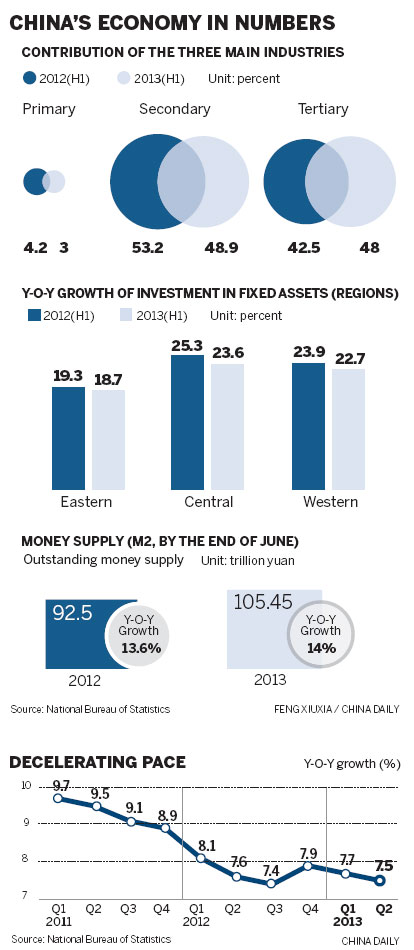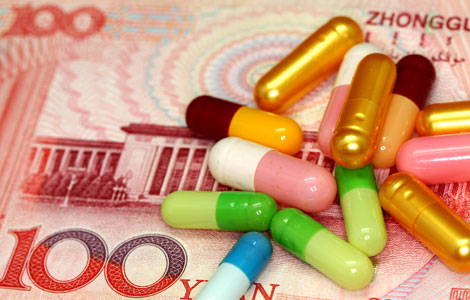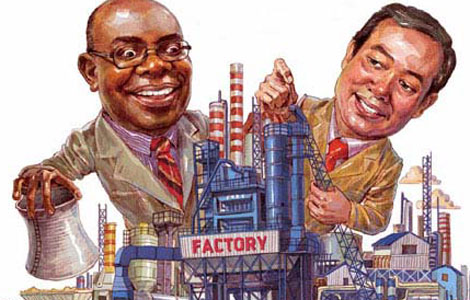Investment falters as industrial activity flags
Updated: 2013-07-19 09:17
By Wei Tian (China Daily)
|
|||||||||||

First-half figures show investors favor central regions
China's investment growth decelerated further in the second quarter amid flagging industrial activity, and it may remain at a low ebb, economists say, as a massive stimulus is not on the cards.
First-half fixed-asset investment grew 20.1 percent year-on-year to 18.1 trillion yuan ($2.94 trillion), the National Bureau of Statistics said on Monday.
The growth rate was 0.8 percentage point slower than in the first quarter and 0.3 point slower than a year earlier, the NBS says.
First-half investment in central regions grew the fastest, by 23.6 percent, followed by 22.7 percent in the west and 18.7 percent in the east. Investment growth has been slowing since it stood at 21.1 percent in the first two months of the year.
"Investment in the manufacturing sector, which accounts for about 40 percent of total investment growth, has already tumbled to the lowest in a decade," says Lu Zhengwei, chief economist with Industrial Bank Co Ltd.
According to Monday's data, investment in the industrial sector hit 7.8 trillion yuan in the first half, up 15.6 percent from a year earlier. Investment in primary industry and the service sector grew 33.5 percent and 23.5 percent, respectively.
The figures were in line with conditions measured by the HSBC Purchasing Managers' Index, which contracted in May and June. The June reading of 48.2 was the lowest in the past nine months.
Decelerating investment growth partly reflected a continued slowdown of economic expansion, which eased to 7.6 percent in the first half from 7.7 percent in the first quarter.
Hu Yifan, chief economist with Haitong International Securities Co Ltd, says slowing investment growth was the outcome of a smaller number of new projects in the second quarter. In June, the National Development and Reform Commission only approved two new projects, she says.
"Because of the absence of support policies, any change in the investment growth rate will depend on whether there are massive infrastructure projects in the months to come," Hu says.
First-half infrastructure investment (excluding utilities) rose 25.3 percent to 2.73 trillion yuan, according to the data released on Monday.
Investment in the property sector totaled 3.68 trillion yuan, up 20.3 percent. The growth rate was up 3.7 percentage points year-on-year and up 0.1 percentage point from the first quarter.
Tang Jianwei, a senior analyst with the Bank of Communications Co Ltd, isn't optimistic about any rebound in investment growth in the second half.
"The expansion of investment in the infrastructure and property sectors will choke off capital to other sectors amid a stringent monetary policy environment. A continuously gliding manufacturing sector will also restrict the upward trend of investment growth," he says, explaining that falling industrial product prices and overcapacity are curbing companies' willingness to invest.
Tang says the government might take further moves to support investment growth in the second half, especially in the areas of urban renovation, environmental protection and information. He forecasts that full-year fixed-asset investment will expand 20.4 percent.
Fan Jianping, chief economist at the State Information Center, a government think tank, says investment is still the largest contributor to the growth of the world's second-largest economy, accounting for 53.4 percent of the 7.6 percent growth in the first half.
weitian@chinadaily.com.cn
(China Daily European Weekly 07/19/2013 page21)
Today's Top News
List of approved GM food clarified
ID checks for express deliveries in Guangdong
Govt to expand elderly care
University asks freshmen to sign suicide disclaimer
Tibet gears up for new climbing season
Media asked to promote Sino-Indian ties
Shots fired at Washington Navy Yard
Minimum growth rate set at 7%
Hot Topics
Lunar probe , China growth forecasts, Emission rules get tougher, China seen through 'colored lens', International board,
Editor's Picks

|

|

|

|

|

|





